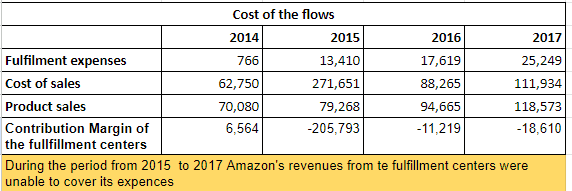This case study examines Amazon’s supply chain management, its competitive advantage compared to brick-and-mortar retailers, as well as the advantages of its distribution strategy. It aims to provide recommendations and an implementation plan for Amazon to reach channel efficiency.
 |
The key marketing issue dealt with is improving Amazon's channel efficiency and coordination while managing the supply chain effectively.
Amazon’s Supply Chain VS Traditional Brick-and-Mortar Retailers
| Amazon | Brick-and-mortar | |
|---|---|---|
| Order management | Ordering is based on speculation: anticipation reduces customer waiting time compared to regular brick-and-mortar stores. | Ordering is based on postponement: when an order threshold is reached. |
| Technology | Technology accelerates workflows, particularly in warehouses to automate inventory management. | Slow adoption of technological advances. |
| Variety of supplies | Supplies are from varied sources worldwide (depth of variety) | Supplies are mainly from China. |
| Assortment recommendations | Customer preferences and purchase patterns drive assortment. | Category captains plan assortments with their expert knowledge. |
| Shipment and Freight | Vertical integration allowed for control over air, sea, and ground shipping. | The shipping of inventories is outsourced to third-party logistics providers and freight forwarders. |
Key Advantages to the Structure of Amazon’s Supply Chain and Distribution Strategy
A 150% increase in net income was no coincidence for Amazon. It was the result of a huge investment that changed its entire marketing channels to a dual-channel structure:
- Backward integration: To have high control over its supply chain, Amazon was not only selling its suppliers’ products but also its own. Additionally, it acquired Whole Foods Market.
- Forward integration: By disintermediation and having its own freight forwarding system, Amazon decreased its dependence on several intermediaries, mainly USP and FedEx, and decreased its distribution costs.
Its distribution strategies resulted in the following key advantages:
- Low costs: According to its Flywheel of growth, Amazon is focusing on a low-cost structure. It achieved it through automation, vertical integration, and innovation.
- Low dependence on suppliers: With more than 2 million third-party sellers, first and second-party sellers, and its branded products, Amazon’s reliance on suppliers is minimal.
- Product variety: Amazon provided customers with more than 573 million different products.
- Customer centricity: as shown on the Flywheel of growth, low costs resulted in low prices, which provided an excellent customer experience, thus driving more traffic. But the price is not Amazon’s only differentiator, it had low waiting time and delivery time, with several delivery options, as well as a huge coverage, in the U.S. and abroad, reaching its different segments.
- Increase in revenues: Amazon reached a 99.87% increase in revenues from 2014 until 2017 (Table 1). Despite the costs of fulfillment centers (Table 2) and a loss on the international level ($3,062 million in 2017), its disintermediation strategy paid off in the U.S., especially after it started building its air and truck fleet.
- High turnover ratio: In 2015, Amazon had a turnover ratio of 26,52% (Table 3), which demonstrates the efficiency and speed of its delivery.
Thus, Amazon's supply chain and distribution strategy gave it the advantage of both efficiency and effectiveness.
Recommendations and Plan of Implementation
| Recommendation | Implementation |
|---|---|
| Amazon should reduce packaging waste and use renewable energy in its distribution system to highlight sustainability. | Utilize solar or wind power in distribution centers and partner with eco-friendly suppliers. |
| Amazon should manage its dual-channel format, by focusing more on coordination and potential conflict resolution. |
|
| It should continue to invest in widening its product variety and assortment to reduce inter-brand competition. |
|
| Exclusivity in certain luxury brands | Partnering with luxury brands could add an element of exclusivity to Amazon's platform and allow it to offer a specialized shopping offer for luxury shoppers. |
| Increase the focus on customer experience |
|
| Invest more in AWS | Information, knowledge, and innovation are the pillars of IT competitive advantage, so Amazon should invest money in R&D to increase expert power. |
| Close supply-side gaps on the international level | Use specialized members while vertical integration is finalized for the international level. |
Authorship:
As part of the Marketing Channels course at Tunis Business School (TBS), this project was conducted by: Azza Ben Attia, Mohamed Ali Ben Ayed, Ons Hamdene, Sahar Dronga, and Yasmine Jedidi. All collaborators granted The Marketing Recipe the copyright of the material above.
Appendix:
Table 1: Percentage Change in Revenues

|

|

|
